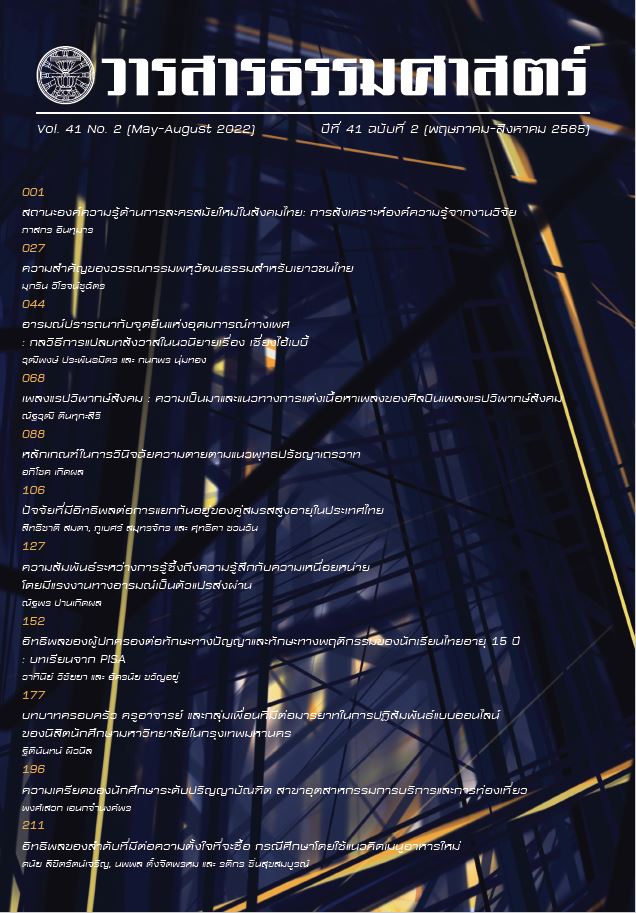The Roles of Family, Teachers, and Peer Group and the Effects on Online Interaction Etiquette of University Students in Bangkok
Main Article Content
Abstract
This research aims to study the relationship between online interaction and roles of family, teachers, and students and social etiquette in online interaction of students in Bangkok. This research employed both quantitative research method using multiple probability sampling of 1,200 samples from 8 universities in Bangkok, and qualitative method using an in-depth interview of 40 participants. This research was conducted in the 2018 and 2019 academic years. The multiple regression analysis was applied for analyzing the quantitative relationship, whereas the qualitative research was conducted via typological data analysis and content analysis. The results showed that the roles of friends played a crucial part, and the family members ranked second. The roles of regulation showed that the family played this role highest, while friends were second. For the part of fostering online-interaction etiquette, the family role was higher than friends and teachers. However, multiple analyses of regression coefficient found that the more family and friends engage in students’ online interaction, the stricter the etiquette increased. On the contrary, the engagement in online interaction of the teachers had decreased students’ awareness of others. This study pointed out that teachers’ roles in encouraging students’ awareness were still very few. At a policy implementation level, there would be a self-learning lesson on online etiquette for young people from what happened along with an emphasis on critical thinking. Besides, the roles of family and teachers in giving up-to-date advice are of significance.
Article Details
References
จุลนี เทียนไทย, ภัทรพรรณ ทำดี, ภาสนันทน์ อัศวรักษ์, ปุณณฑรีย์ เจียวิริยบุญญา, และฐิตินันทน์ ผิวนิล. (2564). การสร้างความเข้าใจในคุณลักษณะ พฤติกรรม และทัศนคติในอนาคตของชาวดิจิทัลไทย. กรุงเทพฯ: สำนักงานการวิจัยแห่งชาติ.
เทพพร มังธานี. (2557). บทบาทของครอบครัวในการปลูกฝังจริยธรรมแก่เยาวชนในภาคอีสาน. Humanities and Social Sciences, 31(1), 45-64.
พนม คลี่ฉายา. (2556). แนวโน้มวิชาชีพ หลักสูตร และคุณสมบัติพึงประสงค์ของบัณฑิตสาขาวิชาการประชาสัมพันธ์. วารสารการประชาสัมพันธ์และการโฆษณา, 8(2), 31-53.
พรชนก เรืองวีรยุทธ. (2550). การพัฒนาบุคลิกภาพการสื่อสารเชิงวัจนะและอวัจนะของเด็กไทยอายุ 16-18 ปี (วิทยานิพนธ์ปริญญามหาบัณฑิต). จุฬาลงกรณ์มหาวิทยาลัย, คณะนิเทศศาสตร์, สาขาวาทวิทยา.
พระคทา สคารโว, พระวิเทศพรหมคุณ, และบุญเลิศ จีรภัทร์. (2561). กิจกรรมการเรียนรู้บทบาทสมมติ เรื่องมารยาทไทย นักเรียนชั้นมัธยมศึกษาปีที่ 2 โรงเรียนทวีวัฒนา เขตยานนาวา กรุงเทพมหานคร. วารสารครุศาสตร์ปริทรรศน์ คณะครุศาสตร์ มหาวิทยาลัยมหาจุฬา
ลงกรณราชวิทยาลัย, 5(2), 139-146.
พัชราภา ตันติชูเวช. (2560). เจเนอเรชันแอลฟา: เจเนอเรชันใหม่ในสังคมไทยศตวรรษที่ 21. กรุงเทพฯ: สำนักพิมพ์แห่งจุฬาลงกรณ์มหาวิทยาลัย.
พิมพาภรณ์ บุญประเสริฐ. (2554). อัตลักษณ์ไทยในการอบรมเลี้ยงดูเด็กเรื่องมารยาททางวาจา. Naraesuan University Journal: Science and Technology (NUJST), 19(1), 75-80.
เพชรา พิพัฒน์สันติกุล, โสริยา ชิโนดม, สมใจ หุตะสุขพัฒน์, และสราณีย์ สุทธิศรีปก. (2561). การพัฒนารูปแบบการจัดการเรียนรู้ของคณาจารย์มหาวิทยาลัยเทคโนโลยีราชมงคลกรุงเทพ. วารสารวิจัย มสด., 14(1), 73-90.
ภูเบศร์ สมุทรจักร. (2560, กุมภาพันธ์ 23). คนเจนวาย กับความท้าทายในสังคมยุคใหม่ [วีดิทัศน์]. สืบค้นจาก https://www.youtube.com/watch?v=9vqwZ6acMkU
มูลนิธิส่งเสริมสื่อเด็กและเยาวชน. (2562). ทักษะการเอาใจเขามาใส่ใจเราทางดิจิทัล (Digital Empathy). ปทุมธานี: วอล์ค ออน คลาวด์.
รุ่งฤทัย จตุรภุชพรพงศ์. (2556). ปัจจัยที่ส่งเสริมการแสดงมารยาทไทยของนักเรียนระดับชั้นมัธยมศึกษาตอนปลาย อำเภอพุทธมณฑล จังหวัดนครปฐม. Veridian E-Journal, Silpakorn University (Humanities, Social Sciences and arts), 6(2), 531-540.
ลือรัตน์ อนุรัตน์พานิช. (2559). เจนเอ็กซ์ เจนวาย เจนแซด คืออะไร. สืบค้นจาก http://www.pharmacy.mahidol.ac.th/th/knowledge/article/330.
วสันต์ ปัญญาแก้ว (2553). การขัดเกลาทางสังคม. ใน แนวความคิดพื้นฐานทางสังคมและวัฒนธรรม (พิมพ์ครั้งที่ 3). เชียงใหม่: ภาควิชาสังคมวิทยาและมานุษยวิทยา คณะสังคมศาสตร์ มหาวิทยาลัยเชียงใหม่.
ศุภลักษณ์ พลายแสง, วีรพงศ์ เฉลิมรุ่งโรจน์, พิชชาพร สุนทรนนท์, และธวัชชัย ศรีเทพ. (2562). เทคโนโลยีสารสนเทศและการสื่อสารกับ EQ ในเด็กปฐมวัย. วารสารบัวบัณฑิตบริหารการ ศึกษา, 19(4), 22-37.
สาคร ใจเด็จ. (2562). การศึกษาผลของการใช้รูปแบบกิจกรรมการเรียนรู้เชิงบูรณาการแบบ IMAS ต่อคุณลักษณะ มารยาทไทยของนักเรียนโครงการภาคภาษาอังกฤษ ระดับมัธยมศึกษาตอนต้น. Journal of Behavioral Science for Development, 11(1), 107-123.
สายสุดา ปั้นตระกูล. (2553). พฤติกรรมการเล่มเกมออนไลน์ของนักศึกษามหาวิทยาลัยราชภัฏ
สวนดุสิต ชั้นปีที่ 1. Panyapiwat Journal, 3(1), 47-59.
สีปะเสิด แก้วบัวบาน และสวัสดิ์ โพธิวัฒน์. (2555). การวิจัยเชิงปฏิบัติการแบบมีส่วนร่วมเพื่อพัฒนามารยาทของนักศึกษา วิทยาลัยสะหวันบริหารธุรกิจ แขวงสะหวันนะเขต สาธารณรัฐประชาธิปไตย ประชาชนลาว. วารสารบัณฑิตศึกษามหาวิทยาลัยราชภัฏสกลนคร, 9(44), 85-94.
สุพิศ รุ่งเรืองศรี และอุดมรัตน์ สงวนศิริธรรม. (2558). ความสุภาพและมารยาทสังคมของนักศึกษานำพาสู่ความสำเร็จในการทำงาน. พยาบาลสาร, 42(ฉบับพิเศษ), 149-155.
สำนักงานคณะกรรมการการอุดมศึกษา. (2560). สถิติอุดมศึกษา. สืบค้นจาก http://www.info.mua.go.th/info/table_stat_02.php?page=2&data_show=
สำนักงานพัฒนาธุรกรรมทางอิเล็กทรอนิกส์ (องค์การมหาชน). (2562). รายงานผลการสำรวจพฤติกรรมผู้ใช้อินเทอร์เน็ตในประเทศไทย ปี 2561. สืบค้นจาก https://www.etda.or.
th/publishing-detail/thailand-internet-user-profile-2018.html.
อรนุช พวงทอง. (2561). การพัฒนาหนังสืออ่านเพิ่มเติม กลุ่มสาระการเรียนรู้สังคมศึกษา ศาสนาและวัฒนธรรม ชุด มารยาทไทย สำหรับนักเรียนชั้นมัธยมศึกษาปีที่ 2 (สารนิพนธ์ปริญญามหาบัณฑิต). มหาวิทยาลัยนเรศวร, คณะศึกษาศาสตร์, สาขาวิจัยและประเมินผลทางการศึกษา.
อัฐฉญา แพทย์ศาสตร์ และพัชรินทร์ รุจิรานุกูล. (2563). แนวทางส่งเสริมความฉลาดทางสังคมของนักศึกษาครูมหาวิทยาลัยราชภัฏรำไพพรรณี. วารสารวิชาการศรีปทุม ชลบุรี, 16(3), 145-154.
Frazier, B., Culley, J. M., Hein, L. C., Williams, A., & Tavakoli, A. S. (2014). Social networking policies in nursing education. CIN: Computers, Informatics, Nursing, 32(3), 110-117. doi: 10.1097/CIN.0000000000000030
Harrison, B., Gill, J., & Jalali, A. (2014). Social media etiquette for the modern medical student: a narrative review. International Journal of Medical Students, 2(2), 64-67. doi: 10.5195/ijms.2014.86
Mather, C., Cummings, E., & Nichols, L. (2016). Social media training for professional identity development in undergraduate nurses. Studies in health technology and informatics, 225, 344-348. doi: 10.3233/978-1-61499-658-3-344
Ngamjarus, C., & Chongsuvivatwong, V. (2014). n4Studies: Sample size and power calculations for android. Bangkok: The Royal Golden Jubilee Ph.D. Program - The Thailand Research Fund & Prince of Songkla University.

